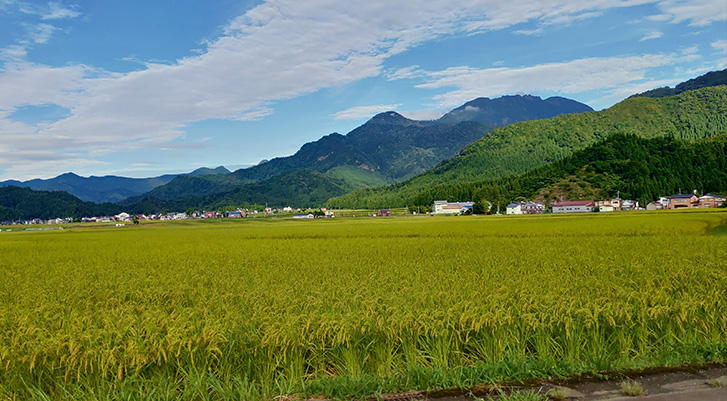
TANBO, Snow Country
Situated at the foothills of Mt. Hakkai, in the Niigata prefecture,
part of the famous snow country region of Japan.
TANBO, Snow Country
The photo represents the lush green paddy fields (tanbo in Japanese) at the foothills of the Hakkaisan range of mountains at the Minami-uonuma city in the Niigata prefecture in north-western Japan. The region experiences heavy snowfall during winters (sometimes more than two-meters), and is known as the snow country. The region boasts of numerous onsens (hot springs) and ski-resorts. The region also produces one of the finest varieties of Japanese rice: Koshihikari. It is interesting to note the kanji (adopted logographic Chinese characters in the Japanese writing system) for tanbo, which represents a paddy field viewed from above.
Japanese farmers from the village of Inakadate, in the Aomori prefecture have turned paddy cultivation into an art form, wherein, they have created intricate frescoes and designs by cultivating different varieties of rice in the same field. This art form (known as Tanbo art) has since become a major tourist attraction. The influence of Tanbo art has reached as far as the Wayanad district in northern Kerala in India (a part of the picturesque Malabar region). In Wayanad, a father (the farmer), inspired by his daughter, has started creating Tanbo art. One of his creations include a depiction of Guruvayur Kesavan, a famous elephant belonging to the Guruvayur temple in Kerala.
Given the significance of rice in Japanese culture, the Hobonichi Company came up with a tanbo-in-a-box concept, wherefrom children can understand, appreciate, and learn from growing rice very in their home very easily and conveniently. The project by the Hobonichi was also initiated to support the rice farmers of Fukushima.
The snow bleached Chijimi cloth, known for their subtlety as well as sublimity, and highly painstaking to produce, also belongs to the snow country region of Japan. Chijimi features allegorically in Yasunari Kawabata’s magnum opus: Snow Country (Yukiguni in Japanese). Kawabata’s novel has immortalized the region through his poignant storytelling of the lead character: Komako, a geisha from the Yuzawa province. Kawabata was the first Nobel laureate in literature from Japan and the second Asian to win the prize after Rabindranath Tagore. Kawabata was an ardent admirer of Rabindranath Tagore and was deeply influenced by his work. Both Kawabata and Rabindranath espoused the spirit of universal humanism, one of the founding principles of IJRC.

